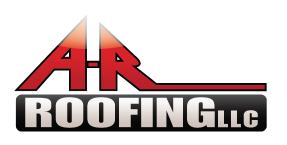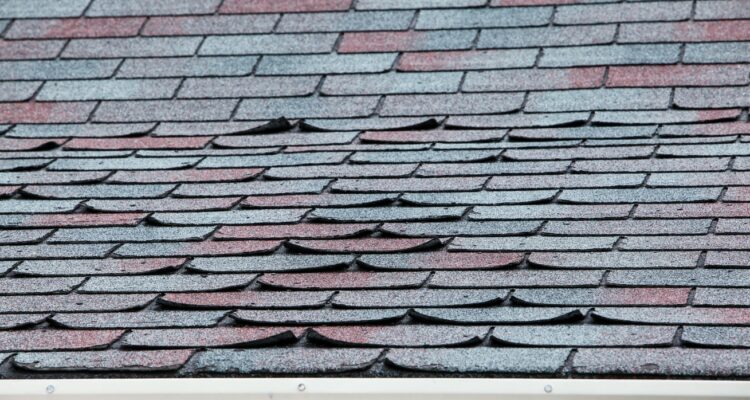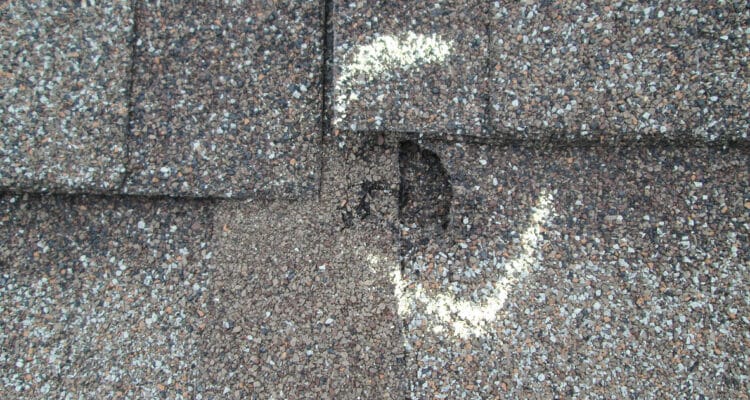Wind damage roof claims rank among the leading reasons property owners file claims with insurance…

How to Identify and Address Roof Storm Damage
After this storm season, who wouldn’t be concerned about storm damage? Our area of the Midwest is known for extreme weather systems. During these severe weather events, your home’s roof is subjected to high winds, heavy rain, hail and even snow and ice.
At AR Roofing, we want you to understand the types of weather that can cause structural damage to your roof and what to do if you see signs of roof damage. If you have experienced roof damage but need guidance on insurance filing, the roof repair process and more – talk to us, we’ll meet you where you are at!
Identifying the Signs of Storm Damage on Your Central Plains Roof
After each storm, it’s important that you check your roof for damage. To do this, you don’t necessarily need to break out a ladder, but you might want to invest in a good pair of binoculars that will allow you to see your shingles clearly while avoiding the risk of falling.

Look for Damaged Shingles
After the severe weather event has passed, step outside and inspect your roof shingles or flat roof for signs of damage. If you have asphalt shingles, you may notice missing granules, curling at the corners of the shingles, broken or cracked shingles and shingles that are completely missing. If your roof has wood shakes, you may see signs of mold or rot, or the shakes may be split or cracked.
If you own a property with a flat roof, look for tears in the roofing membrane, wrinkles and blistering or bubbling.
Examine Gutters and Leading Edges
When you’re inspecting your roof for damage, don’t forget to look at your gutters, soffits and fascia. Your roof’s soffit consists of a board that runs under your roof’s drip edge, and it’s used to attach your gutters. While you’re examining the fascia, it’s a good idea to look for loose or falling gutters. The fascia consists of the siding-like panels that span the underside of your roof’s overhang. You may also see it on the overhang of your porch. Check these boards for signs of peeling paint, cracking, water stains, rot and mold.
Look for Water Damage Inside Your Home
Walk through your home and look at your ceiling. Do you see any yellow, brown or black stains that could indicate a water leak? When you see stains like this, it means that water is leaking from your roof and landing on your attic insulation, where it’s seeping through to the drywall.
Additionally, if you have an attic access door, you may want to climb up to the attic with a flashlight. Check the underside of your roof for water spots, rot and mold. You might also want to look for rusty brackets and nails. This indicates that moisture is present in your attic and should be addressed.
Roof Storm Damage and Homeowners Insurance
If you’ve noticed damage to your roof after a severe weather event, your homeowner’s insurance may cover the repairs or roof replacement. The first step involves filing a claim. What sets us apart at AR Roofing is that we have a dedicated team of specialists who can submit all of the required documentation for your roof damage and work with your insurance company to get your roof repaired or replaced.
Weather That Can Result in Storm Damage to Your Kansas Roof
The roof on your home is designed to protect it against the elements, but that doesn’t mean that your roof will escape every weather event unscathed. Let’s take a second and talk about the types of weather that can result in damage to your roof.
Heavy Rain
Pounding rain storms may sound soothing on your roof and give a sense of peace and ambiance when you look outside, but they can also cause roof damage. Driving rain can wash the granules from your shingles, and if there are any weak spots in your roof, the powerful deluge can result in roofing leaks. This is especially true if the storm comes with high winds. High winds are notorious for blowing debris onto your roof, and that debris can scrape your shingles, causing them to dent, lose additional granules and even become dislodged.
Thunderstorms and Hail
Thunderstorms are characterized by driving rain, high winds and hail. While the high winds blow sticks, leaves and other objects onto your roof and the driving rain strives to wash the shingles from your asphalt roof, the hail is pounding your roof, denting the flashing and vents. Hail can also dent and crack your shingles, leading to water leaks.
Tornadoes
Tornadoes can have wind speeds between 65 and 200+ miles per hour, depending on the EF rating. The extremely high winds from a tornado can remove shingles, and if your roof isn’t properly secured to the exterior walls of your home, it can even lift the entire roof from its supports, resulting in extensive damage to your residential home or commercial building.
Snow and Ice
Winter snow and ice storms can add a significant amount of weight to the structure of your residential or commercial roof. This excess weight can loosen gutters and cause excess stress on your decking and roof trusses, leaving them vulnerable to additional damage from future storms. In addition to the weight, you also have to worry about ice dams. Ice dams occur when the ice or snow partially melts and then refreezes under and along your flashing. The ice dam then holds water on your roof, where it can pool and lead to water damage and roofing leaks.
Hassle-Free Roofing Solutions for Your Storm-Damaged Roof from AR Roofing, Serving the Central Plains
Roof storm damage can negatively impact the structural integrity of your home or business. As soon as you notice that your roof has experienced damage, you should contact an expert team of roofing installers like those at AR Roofing. Our team of roofing specialists can evaluate the damage to your roof and work with your insurance company to come up with a plan to repair or replace your roof.
If you have storm damage on your roof, don’t wait until you see a visible leak. We can handle the toughest residential and commercial roofing repairs in central Kansas and beyond.


